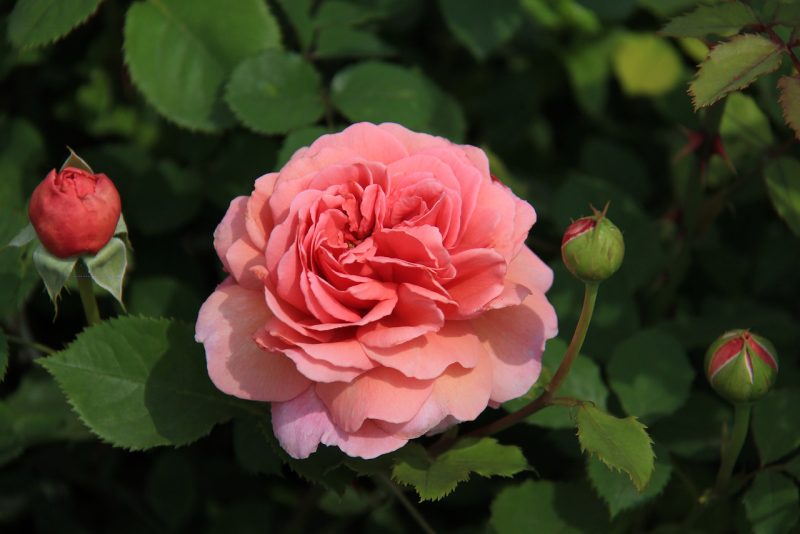Many amateur gardeners do not dare to plant the “Queen of Flowers”, motivating this with the fact that roses are rather capricious plants. Caring for them will require a lot of effort and time, and the result may not justify itself. Having such concerns, it is worth looking closely at the polyanthus roses. They are distinguished by the brightness of flowers, delight with aroma. In addition, these varieties are usually frost-resistant, and this is a huge plus for those who live in the northern regions of Russia, the Urals and Siberia.
Material Content:
What is a polyanthus rose, the main characteristics
"Polyanthus" - means "having many colors." Bushes are usually low, although there are exceptions. The sheets are bright, smooth, in themselves look very elegant. Roses are collected in inflorescences, they bloom from the third decade of May until the end of October. Bushes can reach 60 - 70 cm in height.
The flowers themselves are small - up to 4 cm, but very fragrant. Typically, polyanthus roses are red, pink, white. There are so many flowers that foliage is hardly visible behind them. Each rose has a large number of petals (up to 35), but small leaves are also very elegant. Their beauty becomes especially noticeable when the rose fades, then it is the emerald green leaves that become its main decoration.
Now the polyanthus is replaced by the rose of floribunda. In this species, the flowers seem more elegant, and they are larger in size. But unpretentious polyanthus roses continue to find their fans among flower growers even today.
The best varieties of polyanthus roses
Varieties will surprise with their variety even sophisticated gardeners. Low-growing, perhaps the most optimal for planting at home or as a border plant.
- "Angel wings".Another name for this variety is known - "Angel Rose". The bush is low, about 30 cm. The flowers are very elegant, terry. Leaflets, like other varieties, are unusually elegant, seem to be varnished.
- "Ivano Rabier." It is worth paying attention to this variety. Firstly, white polyanthus roses are rare. Secondly, very large inflorescences impress. Thirdly, a strong aroma will please.
- The Orange Triumph. The variety is higher than the rest, reaches half a meter. It will make a beautiful hedge, all in the colors of orange.
Well, if you need to make a polyanthus rose the center of the flower garden, you should pay attention to such varieties:
- “Spartak” is a tall bush, up to 80 cm. The flowers are unusually large for a polyanthus, with very beautiful shapes. May be red and orange.
- “Flame of the East” is the pride of domestic selection. Single flowers of bright, truly "fiery" color.
- "Concert" is another red rose, but already the owner of large spectacular inflorescences.
- "Georg Elger." The height of this bush is average. Roses look very elegant, have a noble orange color.
- "Iceberg". As the name implies, this is another white rose. One of the highest grades - reaches 1.5 m. A gentle and yet stable aroma brought him fame.
- "Masquerade". The bush is of medium height. Bright flowers look festive. From these warm-colored roses you can make an excellent composition, because the rose “Masquerade” is unusually spectacular.
- Royal Minueto. This bush, reaching 60 cm in height, is a real decoration of the garden. Raspberry edging of a very saturated color, milky white petals and creamy core color make the flowers unusually beautiful. The rose polyanthus Royal Minueto becomes a real favorite of the flower garden.
These rose varieties can also be used as hedges.
Growing roses from seeds at home and care features
Seeds are collected from slightly immature boxes and stored in a dry place. It is best to start preparing in early December, so that the plants begin to emerge in the spring.
- It is necessary to hold the seeds in a weak solution of potassium permanganate for about 10 minutes, and then rinse. This is done with the aim of disinfection.
- Then comes the turn of soaking in the stimulator.
- Next, the seeds are planted in the ground, and then either placed in the refrigerator, or instilled in the garden. In order for small roses to sprout safely in the spring, they need to be kept in the cold for a couple of months.
- In the spring, the container is placed on the windowsill. It is extremely important for a polyanthus rose to observe the temperature regime: the room should be about 20 degrees. Also, one should not forget about lighting the sprouts: at least ten hours a day. Sometimes use artificial light.
- At the end of May, when there are no frosts, you can plant the shoots of roses on the street. The pits are needed deep enough so that the roots do not have to be bent. Mineral top dressing is put at the bottom. You can use ash, humus. If the soil in the flower garden is heavy, clay, it is advisable to add sand.
Caring for this kind of roses is not difficult. In the spring they are pruned and branches that have not survived the winter are removed. Watered 1-2 times a week, if necessary, treated with special drugs that destroy pests.
Bushes can be formed. The tops of the shoots are cut off, and as a result, side shoots begin to develop. For the winter, roses are pruned and covered.
Mulching
Mulching doesn’t just make the job easier for the landlord (you don’t have to weed so often). Largely thanks to mulching, roses develop correctly, are covered with many buds, and avoid dangerous diseases.
Under the mulch layer, moisture is better preserved, the soil does not compact. It can be used as sawdust, needles or straw, thereby improving the soil and facilitating the care of plants.
The order of work is as follows:
- First, where roses grow, weeds are weed.
- Then a layer of mulch is poured up to 6 cm thick.
- Then they wait for it to turn into humus.
- Loosen the soil, mixing the mulch with the topsoil, and then pour a new layer of mulch.
Diseases and Pests
Polyanthus roses are unpretentious and hardy plants, and yet you need to be wary of diseases and pests, and if they are detected, take the necessary measures in time.
What pests threaten landings?
- Aphid. The smallest green insects can settle on any part of plants - on leaves, stems. But especially they like buds. It is just a pity to prune future flowers to get rid of aphids. If there are not too many roses on the plot, you should just try to “wipe” the aphids from the buds, but you can donate leaves. After that, all the bushes are treated with special preparations.
- Rose Cicadas. These insects are white or greenish especially often threaten roses in hot, dry weather. They are hiding on the back of the leaves. Cicadas are capable of causing great damage, because they suck juice from the leaves. Fortunately, getting rid of them is not too difficult. It is enough to spray the bushes with a solution based on laundry soap.
- Spider mite. The smallest pest can be seen if you examine the leaves of roses on the underside. You will see yellow spots. If you do not take action, the leaves fade, turn gray. If the leaves are severely affected, they are removed. Plants are treated with a decoction of horsetail or yarrow (drugs can be purchased at the pharmacy).
- Rose leaflet. This pest loves to lay its eggs on leaves. A characteristic sign of infection - the leaves begin to curl. A good defense is a complex insecticide.
Rosary rotter. After the rotter lays its eggs, the larvae that are born begin to eat holes in the stems of the roses. In this case, it is better to cut the stems, and spray the bush with infusion of wormwood.
The main diseases of polyanthus roses:
- Black spotting. As the name suggests, ugly dark spots form on the leaves. The leaves dry out. To save the bush, it needs to be treated with a decoction of horsetail or ordinary nettle.
- Powdery Mildew The real scourge of the Queen of flowers. Roses are especially affected if rainy weather sets. Characteristic spots are visible on the leaves - as if a flour solution had dried. Bordeaux fluid is effective in this case.
- Rose rust. And these spots have a characteristic color for rust - yellow or brown. Bordeaux fluid will also help.
Growing polyanthus roses is not as difficult as it seems. A little zeal is worth making, and wonderful varieties will reward you with wonderful long-lasting flowering.

















